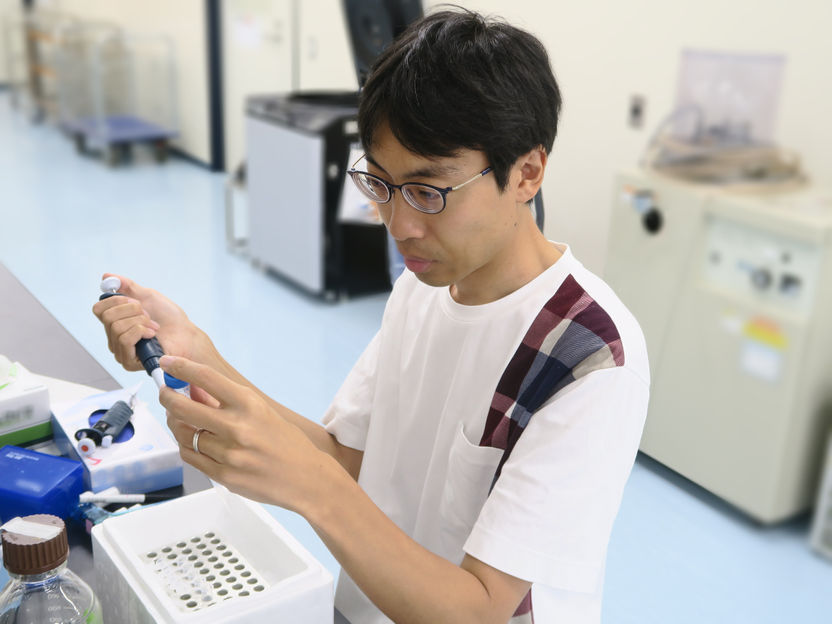Genetic methods enable use of fossil lipids as biomarkers for oxygen-producing primordial bacteria
New study in Nature Ecology & Evolution provides important basis for deciphering the evolutionary history of life on Earth
Advertisement
cyanobacteria are a key species in Earth's history, as they introduced atmospheric oxygen for the first time. The analysis of their evolution therefore provides important insights into the formation of the modern aerobic ecosystem. To this end, a certain type of fossil lipid, known as 2-methylhopanes, was long thought to be an important biomarker in sediments, some of which are hundreds of millions of years old. However, this came into doubt when it turned out that not only cyanobacteria but also Alphaproteobacteria are genetically capable of producing these lipids.
An international research team led by Yosuke Hoshino and Christian Hallmann from the GFZ German Research Center for Geosciences and Benjamin Nettersheim from MARUM - Center for Marine Environmental Sciences at the University of Bremen has now investigated the phylogenetic evolution and distribution of some genes - including HpnP - responsible for the synthesis of the lipid 2-methylhopane: The researchers have deciphered when these genes were acquired by specific groups of organisms. They were thus able to show that HpnP was probably already present in the last common ancestor of cyanobacteria more than two billion years ago, while the gene only appeared in alphaproteobacteria about 750 million years ago. Thus, for times before that, 2-methylhopanes can still serve as a unique biomarker for oxygen-producing cyanobacteria.
The study now published shows how genetics, in concert with sedimentology, paleobiology, geochemistry, can improve the diagnostic value of biomarkers and refine the reconstruction of early ecosystems.

Dr. Yosuke Hoshino (GFZ) is conducting biological analyses as part of the study.
Mikio Tanabe, KEK Japan
The importance of cyanobacteria in Earth's history.
Cyanobacteria played a critical role in transforming the Earth from its initial oxygen-free state to a modern, oxygen-rich system in which increasingly complex life is possible. Cyanobacteria were probably the only relevant group of organisms that converted inorganic to organic matter (called primary producers) and produced oxygen for much of the Precambrian (the first four billion or so years of Earth's history, from its beginnings to about 540 million years ago). Therefore, the analysis of their evolutionary development is of great importance for understanding the common history of life and Earth.
The importance of fossil lipids as biomarkers
In principle, the fossil remains of whole cyanobacteria can serve as indicators of the presence of oxygenic photosynthesis in the geological past. However, due to preservation biases and ambiguities in the recognition of fossil cyanobacterial cells, geochemists:in use fossil diagnostic lipids such as 2-methylhopanoids for their research. 2-Methylhopanoids, as the non-fossilized molecules are called, are produced by bacteria and they are detectable in sedimentary rocks in a fossilized state - unlike bacteria - even after hundreds of millions of years in good quality and quantity corresponding to their original occurrence.
However, the suitability of 2-methylhopane as a biomarker for cyanobacteria has recently been in doubt: the discovery of a gene for lipid biosynthesis revealed that alphaproteobacteria are also capable of producing these lipids. This meant that the temporal classification of oxygen-producing processes was no longer unambiguously possible.
New approach: Comprehensive genetic analysis combined with new, high-purity sediment analyses
An international research team led by Yosuke Hoshino, a scientist in GFZ Section 3.2 "Organic Geochemistry", and Section Leader Christian Hallmann, also a professor at the University of Potsdam, and Benjamin Nettersheim from MARUM at the University of Bremen, has now systematically investigated which organisms other than cyanobacteria possess the genes with the abbreviation SC and HpnP, which are necessary for the production of 2-methylhopanoid, and when they acquired them during their evolutionary history. In this way, the team was able to show that the fossil lipid 2-methylhopan can continue to be used as a unique biomarker for the existence of cyanobacteria for times dating back more than 750 million years.
In addition, the researchers created an integrated representation of 2-methylhopane production throughout Earth's history. For this, they combined their molecular data with new sediment analyses conducted under high-purity conditions.
"The method we proposed is in principle applicable to any organic matter in geological archives and has great potential to track the evolutionary development of different ecosystems with much higher temporal and spatial resolution than before," Hoshino summarizes.
Methodology I: Computer study for gene analysis
To analyze the genetic relationships, Hoshino searched publicly available online databases containing millions of gene/protein sequences for organisms with SC and HpnP genes. Based on this genetic dataset, he created so-called phylogenetic trees, which provide information on how the SC and HpnP genes were transferred between different organisms and whether the gene transfer occurred vertically via inheritance or horizontally between evolutionarily unrelated organisms.
In addition, the researchers were also able to determine when individual gene transfers occurred in the evolutionary history of the genes. For this, they consulted previous studies that operated with the so-called molecular clock technique, which takes into account the DNA mutation rate and estimates the time course of gene evolution.
Methodology II: New type of ultra-clean sample preparation.
In addition, because Precambrian biomarker datasets are highly sensitive to contamination, the researchers used an ultra-clean method to extract organic matter from sediment cores. The geological samples, in the form of cores, were collected by several co-authors from 16 countries. They represent different geological periods from the Paleoproterozoic (2.5 billion years ago) to the present. The relative abundance of 2-methylhopanes was then measured in the organic matter.
The results in detail
There are many bacteria that possess SC and HpnP genes, but in the main these are cyanobacteria and alphaproteobacteria. Both groups were found to have acquired the SC and HpnP genes independently. This is in contrast to previous studies that concluded that cyanobacteria acquired these genes from alphaproteobacteria at a late stage in their evolution.
The new study also found that the common ancestor of cyanobacteria possessed both genes more than 2.4 billion years ago, when oxygen began to accumulate in the atmosphere during the so-called Great Oxygen Catastrophe.
In contrast, alphaproteobacteria acquired the SC and HpnP genes no earlier than about 750 million years ago. Before that, 2-methylhopanoids were consequently produced virtually only by cyanobacteria.
The researchers interpret a slightly delayed increase in 2-methylhopanoids in sediments about 600 million years ago as indicative of the global expansion of alphaproteobacteria, which may have favored the concurrent evolutionary rise of eukaryotic algae.
Classification and outlook
"The individual analytical methods mentioned above are not new, but few researchers have performed comprehensive analyses for SC and HpnP and attempted to integrate genetic data with sedimentary biomarker data, as this requires the combination of two completely different scientific disciplines-molecular biology and organic geochemistry," says Hoshino.
"The source of sedimentary 2-methylhopanes has long been controversial," adds Christian Hallmann. "This new study not only provides clarity on the diagnosability of 2-methylhopanes and the role of cyanobacteria in the primordial past; its methodology provides a new way to refine the diagnosability of theoretically any biomarker lipid once the biosynthetic genes are known."
Note: This article has been translated using a computer system without human intervention. LUMITOS offers these automatic translations to present a wider range of current news. Since this article has been translated with automatic translation, it is possible that it contains errors in vocabulary, syntax or grammar. The original article in German can be found here.
Original publication
Yosuke Hoshino, Benjamin J. Nettersheim, David A. Gold, Christian Hallmann, Galina Vinnichenko, Lennart M. van Maldegem, Caleb Bishop, Jochen J. Brocks & Eric A. Gaucher, 2023; "Genetics re-establish the utility of 2-methylhopanes as cyanobacterial biomarkers before 750 million years ago."; Nature Ecology & Evolution
























































